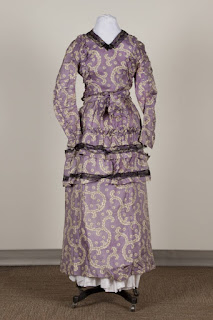We found this wonderful quick guide to dating garments on The Vintage Fashion Guild (
http://vintagefashionguild.org/). Below is an excerpt of this fabulous list written by Hollis Jenkins-Evans. Please visit them for more information or the compete list.
Quick Tips for Dating Vintage
Here are just a few quick easy-to-remember tips. These facts don’t necessarily place a garment in a year, but they will help narrow it down.
SEW AND SEW
· The first practical sewing machine was invented in 1845. Not in general use immediately. If is has machine sewing, it’s post 1845.
· Machine chain stitch came first, followed by lockstitch. Lockstitch seams are rarely found prior to 1870.
· Hand-sewn construction (rather than hand finishing) and machine-sewn construction coexisted for years – until the 1880s, if not later.
· The zigzag machine was invented in 1947.
· The serger has been in use since the 1920s for seam finishing. This is the overlock or serger thread finish we still use today on cut fabric edegs inside the garment.
· Hanging loops at the neck of jackets, blouses and so on, are usually of European manufacture.
· Hemming tapes generally denote North American manufacture. German manufacturers never used them.
· Circle stitching inside the cups of a bra is a good indicator that it’s from the 1950s.
A CUT ABOVE
· Watch pockets can be found on the waistline or waistband of dresses 1840s-1880s and elsewhere on the dress bodice from the 1880s.
· Cartridge pleating of the skirt at its waist is seen 1840s-1860s, fading out by the 1870s.
· Tiny piped armhole seams date a garment to the 1870s or before and were rare after that.
· Armholes were cut high and fitted in the 1950s and the 1970s.
· Three-quarter and seven-eighth sleeves were popular late 1930s, 1940s, and 1950s.
· Diamond gussets in the armhole indicate 1950s.
· In 1942, men’s double-breasted suits in the USA lost their vest and became 2-piece due to the war effort.
MATERIAL WORLD
· 18th century silk brocade with white grounds usually denotes English manufacture whereas silk brocade with yellow grounds usually means its French.
· Rayon (known as artificial silk) was a French process developed during the 19th century. AKA Viscose (English process). The name Rayon was coined in 1924 and was used extensively for lingerie and light summer dresses until the 1950s when nylon became popular.
· Dacron¨, trademarked by DuPont and denotes numerous types of polyester yarn. Used in manufacture from 1953.
· Nylon was the first true synthetic developed by DuPont in the 1938, available to the American public in May 1940, used in stockings. Not used in clothing until well after WWII.
· Qiana¨, a filament nylon used for woven and knitted fabrics was registered by DuPont in the 1970s.
· Spandex – first commercial use in 1959, seen in lingerie in the early 1960s, but not in clothing much until the 1980s. (Registered to DuPont as Lycra¨)
http://vintagefashionguild.org/tips-tricks/quick-tips-for-dating-vintage/










